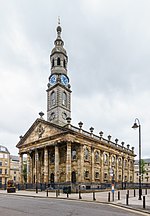Nelson Monument, Glasgow

The Nelson Monument is a commemorative obelisk built in 1806 in honour of Vice Admiral Horatio Nelson, constructed the year after his death at the Battle of Trafalgar. It is located within Glasgow Green, a historic public park in Glasgow, Scotland. It stands 144 feet (44 m) tall, and its square plinth is enclosed by cast iron railings.The obelisk was designed by the architect David Hamilton. A plaque in front of the column records that it was the first civic monument in Britain to Nelson's victories, funded by a public subscription. The foundation stone was laid on 1 August 1806, and the monument was constructed by the mason A. Brockett. Soon after its construction, the obelisk was struck by lightning, leaving a long structural crack in the monument: this event was depicted in a painting by John Knox, which is now in the nearby People's Palace museum. In 1965 a tablet was added to the plinth commemorating James Watt's use of Glasgow Green while thinking about an improved steam engine.The monument became a category A listed building in 1970.
Excerpt from the Wikipedia article Nelson Monument, Glasgow (License: CC BY-SA 3.0, Authors, Images).Nelson Monument, Glasgow
Greendyke Street, Glasgow Calton
Geographical coordinates (GPS) Address External links Nearby Places Show on map
Geographical coordinates (GPS)
| Latitude | Longitude |
|---|---|
| N 55.8515 ° | E -4.24068 ° |
Address
Nelson's Monument
Greendyke Street
G40 1PA Glasgow, Calton
Scotland, United Kingdom
Open on Google Maps






